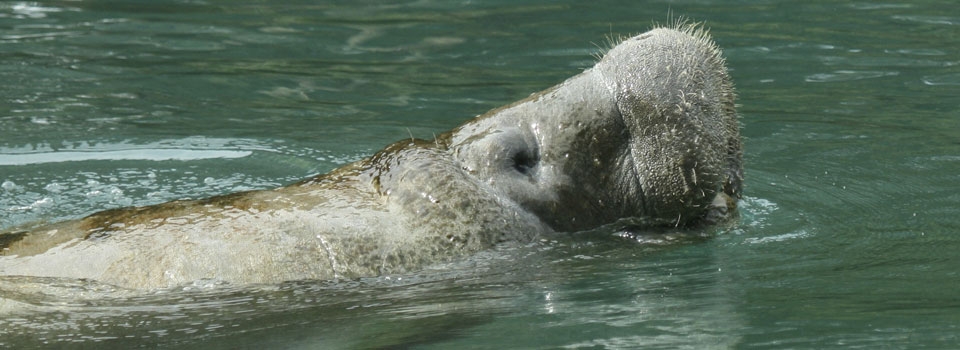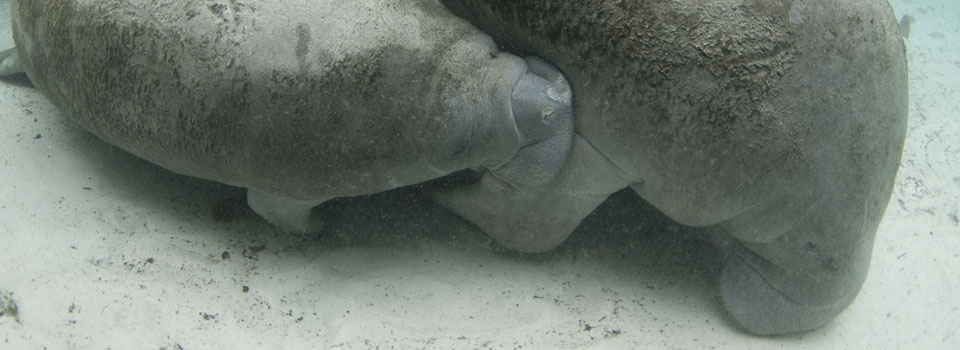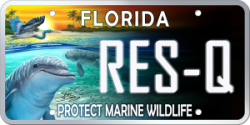Manatee Conservation
There are three species of manatee and all are either threatened or endangered. The West Indian and Amazonian manatees are both endangered, and the West African manatee is threatened, according to the Endangered Species Act. The United States has worked hard to conserve the only manatee residing in U.S. waters, the Florida manatee, sub-species of the West Indian manatee. It is found in the southeastern United States, primarily in waters off the coast of Florida. Its population consists of about 6,000 animals, and it is one of the most endangered animals living in U.S. waters.
Threats to manatees
Since 1974, the Florida Fish and Wildlife Conservation Commission (FWCC) have kept records on manatee mortality. Almost one-third of all known manatee deaths are caused by human factors, and most human-related deaths are due to watercraft collisions. Since 1974 over 1700 manatee deaths have been attributed to watercraft collisions (Florida Fish and Wildlife Institute). Up to eighty-five percent of all manatees that have been identified in Florida are recognized by their scar patterns. The large majority of watercraft collisions involve recreational vessels (FWCC 2003). Manatees are difficult to see floating in the water, and most drivers, unaware of their presence, unknowingly run these animals over. A record number of manatee deaths of 429 were reported in 2009 (Florida Fish and Wildlife Institute). This included 56 deaths from cold stress.Aside from watercraft collisions, the largest amount of human-related mortality is due to entrapment in floodgates and canal locks. Since 1974, over 190 manatees have become entrapped in these gates and died.
Aside from watercraft collisions, the largest amount of human-related mortality is due to entrapment in floodgates and canal locks. Since 1974, 199 manatees have become entrapped in these gates and died (Florida Fish and Wildlife Institute)
Entanglement in fishing line or rope is another major threat. Manatee pectoral flippers that are used for swimming, eating, and nursing can become amputated by entanglement. Monofilament fishing line takes 600 years to bio degrade. The good news is it can be recycled. Dispose of fishing line properly.
Destruction and alteration of manatee habitat may be an even greater threat. For more than a decade, the population of Florida has grown at a rate of 1,000 people per day. Furthermore, over the past two decades, the number of manatees that winter in natural and artificial warm water refuges has increased. All of those manatees congregated in such small areas can increase the spread of disease, and the affects of localized red tides or pollution events. The artificial refuges are maintained by industrialized nuclear power plants which are at risk of operational or economic problems that can lead to temporary or permanent shut-down, leaving the manatees in the cold with no place to go (FWCC 2003).
Manatee Protection in Florida
There has been a great deal of controversy recently about the Florida Fish and Wildlife Conservation Commission’s decision to declassify the status of the Florida manatee from “endangered” to “threatened”. Without taking sides in this issue, we thought it would be of interest to explore the various levels of protection afforded the manatee in Florida and the role of the Florida Fish and Wildlife Conservation Commission (FWCC). To obtain this information visit the FWCC web-site.
There are a number of laws protecting the manatee on the Federal and state level. The manatee is federally protected under both the Endangered Species Act and the Marine Mammal Protection Act.
In Florida, there are several protection laws affecting manatees. Under The Florida Manatee Sanctuary Act (Ch.370.12 (2), F.S., the State of Florida is hereby declared to be a refuge and sanctuary for the manatee. The Act authorizes the FWCC to adopt rules regulating the speed and operation of motorboats to protect manatees from harmful collisions and from harassment. The FWCC may also adopt rules to protect manatee habitats, such as sea grass beds, and may designate limited areas as safe havens for manatees to rest, feed, reproduce, give birth, or nurse their young while undisturbed by human activity. These rules appear in Chapter 68C-22, F.A.C.
The Florida Manatee Recovery Planwas approved by the U. S. Fish and Wildlife Service (FWS) in 1989 and updated in 1996. One task of the plan is to "develop site-specific manatee protection plans at the local level." Secondly, in October, l989, the Governor and Cabinet directed 13 "key" counties to develop Manatee Protection Plans.
The state of Florida has set up several ways to help fund manatee protection efforts. The Save the Manatee Trust Fund receives $1.50 from each vessel registration, donations of $5.00 or more through the manatee decal program, and the Manatee Specialty tag.
The speed zones established under the Florida Marine Sanctuary Act are enacted independent of the manatee’s status through the State rulemaking process. Additionally the manatee is protected at the Federal level by the Endangered Species Act and the Marine Mammal Protection Act. These laws, per the FWCC, specifically provide protection for manatees independent of, and not contingent upon, its status as a listed species.
The FWCC is in the process of developing a management plan for the species’ recovery and has committed to forming a plan that will not weaken manatee protection. For more information you can visit their web site or go to the Save the Manatee Club web site at www.savethemanatee.org.
The Manatee Recovery Plan has focused on reducing the aforementioned threats to manatees. The main focus has been on lowering traffic speed in manatee-frequented areas, and in enforcing those speed limits. The participants have also sought to reduce the harassment of manatees and the feeding and watering of wild manatees. Researchers are working to develop a large-scale manatee die-off contingency plan, and new devices that would prevent deaths in floodgates and canal locks.
What you can do
There are things all of us can do to help protect manatees. Please obey all speed zone signs and look out for manatees when boating. Dispose of your trash properly. Support conservation organizations like DRC. Become politically aware and active.
Do not feed or water a wild manatee!Manatees have been finding their own food and water for thousands of years. They do not need our help. When you feed any wild animal, including the manatee, you bring it closer to its worst enemy, man. In the case of manatees, feeding and watering attracts manatees to marinas where they are more likely to be hit by a boat or become entangled in fishing line or ropes.
If you spot an injured manatee do not try to help it. Call 1-888-404-FWCC and trained manatee assessors can help the animal. You may injure the animal or yourself if you try to be a hero.
Dolphin Research Center’s manatee rescue team works closely with the FWCC and responds to all calls for manatees in distress in the Florida Keys.
References
Florida Fish and Wildlife Research Institute
Florida Fish and Wildlife Conservation Commission













